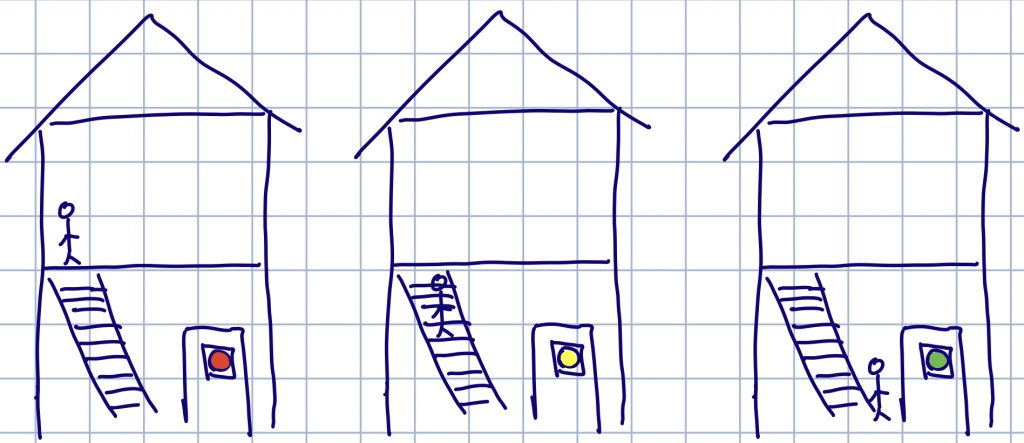Background
“Nowadays, most golfers yell “fore” only after they’ve hit an errant shot toward an unsuspecting golfer, but the term which translates to “watch out!” or “heads up!” was originally intended to be used before teeing off.”
—- quote from here
Golf balls can travel really fast in the air, and hitting by golf balls can cause from severe swellings to permanent damages. When you are playing at the golf course, you yell “Fore!” when:
-
- you didn’t wait for the group in front of you to leave(rude!)
- you hit a really bad ball and you are hitting onto other fairways(not where your ball is suppose to go), and you are not sure whether there are people there.
Because you might hit/injure them, or even just scare them.
When you hear “Fore!” on the golf course, there is usually less than a second for you to react. There are a few things that you can do:
-
- identify where the sound comes from
- hide at a nearby golf cart or tree
- put your hands on your head
- stay low so that the ball does not hit your head
But usually, it’s hard to identify where the sound comes from within such a short period of time, so one usually attempts to do all of above very confused and hope for the best.
Problem
Ever since the early times in the sport of golf, people rely on yelling and hearing “Fore!” to warn each other about a flying ball coming at their directions. This has issues:
-
- People with hearing problems don’t receive the warning
- There is not enough time for people to react to identify where the sound comes from
Proposed Solution

My proposed solution is a “Fore!” wristband. Everyone on the golf course will be wearing it, and it can do the followings:
-
- Sense when “Fore!” warning is made
- Communicate the location/direction of the warning to other wristbands
- Display the direction of the warning

For proof of concept, I will(still don’t have my hardwares yet) use an accelerometer to detect whether a swing is made, a sound sensor to detect whether there is a loud yelling immediately following the swing, and an 8×8 led matrix for the display.
Discussion
The prototype design has a few flaws:
-
- The sound sensor is chosen so that the golfer does not need to make any additional actions of notify other golfers, but the sound sensor only detects for sound above a certain threshold. It’s common for golfers to yell things other than “Fore!” immediately after the swings. For surrounding golfers, the issue should not be too big because the distance makes their yellings quieter. But for the golfer wearing the wristband, this would raise a problem of sending false alarms to other golfers. Possible solutions can be running speech recognition to ensure that “Fore!” is the word, or adding some additional conditions to avoid false alarms.
- In my prototype, I omitted the wireless communication. But the communication can cause some problems if the wristbands are put in use in the real world, since it’s not uncommon for golf courses to have poor signals. So radio signals set up and maintained by the golf course may be a good solution.
 This is my dog and her favorite toy: a blue and green rubber ball. She recently got into the habit that when she wants us humans to play the ball with her and we don’t give her attention, she would roll the ball into places she can’t reach, usually under a desk or behind the TV set. Then she whines until someone gets it for her, which could be minutes if no one decides to get it.
This is my dog and her favorite toy: a blue and green rubber ball. She recently got into the habit that when she wants us humans to play the ball with her and we don’t give her attention, she would roll the ball into places she can’t reach, usually under a desk or behind the TV set. Then she whines until someone gets it for her, which could be minutes if no one decides to get it.










 In the sketch above, we are looking at this house that has two floors and the person inside is on the second floor. After the doorbell rings, if the person does not move to get the door, the doorbell is red and the person outside should keep ringing the bell. If the person inside is on his/her way to the door, the doorbell turns yellow so the person outside is ensured that he/she has gotten the insider person’s attention. It’s likely that the person inside gets distracted and forget about the door, so if doorbell stays yellow for too long, the person outside could ring the bell again. And finally, if the person inside is near the door already, then the doorbell turns green and the person outside can be prepared to see the door open.
In the sketch above, we are looking at this house that has two floors and the person inside is on the second floor. After the doorbell rings, if the person does not move to get the door, the doorbell is red and the person outside should keep ringing the bell. If the person inside is on his/her way to the door, the doorbell turns yellow so the person outside is ensured that he/she has gotten the insider person’s attention. It’s likely that the person inside gets distracted and forget about the door, so if doorbell stays yellow for too long, the person outside could ring the bell again. And finally, if the person inside is near the door already, then the doorbell turns green and the person outside can be prepared to see the door open.